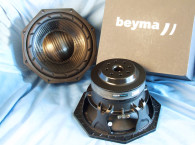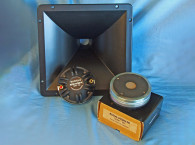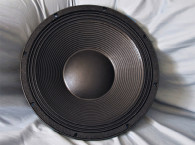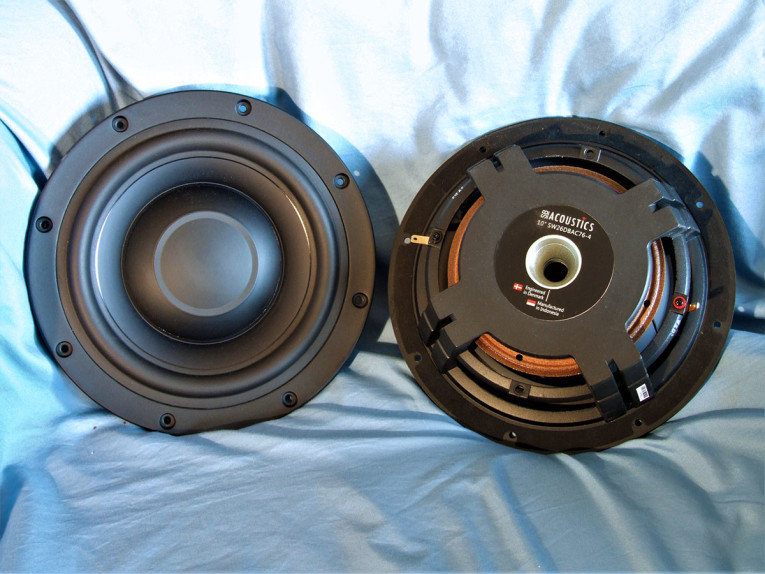
The SW26DBAC76-4 has a unique and interesting feature set that starts with an extremely shallow 79.5mm (3.13”) depth proprietary cast eight-spoke (actually four dual spokes) cast-aluminum frame (Photo 1 and Photo 2). If inset mounted into a 0.75” MDF baffle, the driver would only protrude into the enclosure by about 2.38”.

Other features include the incorporation of a flat 10” dual aluminum cone that is very stiff and reinforced by a large two-piece 136mm (5.36”) dust cap, plus an inverted cone attached at the front cone/dust cap joint. The outside rim of the inverted cone is attached to the outside perimeter of the 162mm diameter spider. In this design, the outside diameter of the spider moves with the cone assembly rather than the inside diameter of the spider connecting and moving with the voice coil assembly.
The inside diameter of the spider that would normally be glued to the voice coil assembly is then connected to the motor structure. This means that the inside diameter of the spider is fixed (stationary) to the motor structure in the same way as the outside diameter of most designs are glued to a frame spider mounting shelf. This is a clever design that reverses the usual traditional connecting the outside diameter of a spider to a frame mounting shelve and the inside diameter to the voice coil assembly.
The cone assembly is driven by a 75.5mm (2.97”) diameter voice coil using a non-magnetically conducting fiber glass former wound with round copper wire. For the motor assembly, SB Acoustics combined a cast return cup and a vented neodymium magnet. For inductance control, the motor also has an aluminum shorting ring (Faraday shield). Convection cooling is provided by a flared 20mm vent in the magnet/return cup, plus eight 6mm diameter vents in the spider. Last, the voice coil is terminated to gold terminals located on opposite sides of the frame to discourage rocking modes.
I began characterizing the SW26DBAC76-4 subwoofer with the LinearX LMS analyzer and Physical LAB IMP Box. Both voltage and admittance (current) measurements were generated in free-air at 0.3V, 1V, 3V, 6V, 10V, 15V, and 20V. I used the measured Mmd taken from the provided SB Acoustics data rather than a single 1V added (delta) mass measurement.
It should also be noted that this multi-voltage parameter test procedure includes heating the voice coil between sweeps for progressively longer periods to simulate operating temperatures at that voltage level (raising the temperature to the third time constant). While certainly dated, the LinearX multi-voltage method remains the best Thiele-Small (T-S) parameter measurement technique available and provides the most accurate prediction of high voltage excursion that I know.
I further processed the 14 sine wave sweeps for each woofer with the voltage curves divided by the current curves to produce impedance curves. I generated the phase curves using the LEAP phase calculation routine. I then copy/pasted the impedance magnitude and phase curves plus the associated voltage curves into the LEAP 5 software’s Guide Curve library.
This data was used to calculate parameters using the LEAP 5 LTD transducer model. Because most manufacturing data is produced using either a standard transducer model or in many cases the LEAP 4 TSL model, I generated a set of LEAP 4 TSL model parameters using the 1V free-air that can also be compared with the manufacturer’s data. Figure 1 shows 1V free-air impedance plot for the SW26DBAC76-4. Table 1 compares the LEAP 5 LTD and LEAP 4 TSL T-S parameter sets for the two SW26DBAC76-4 samples along with the SB Acoustics factory data.
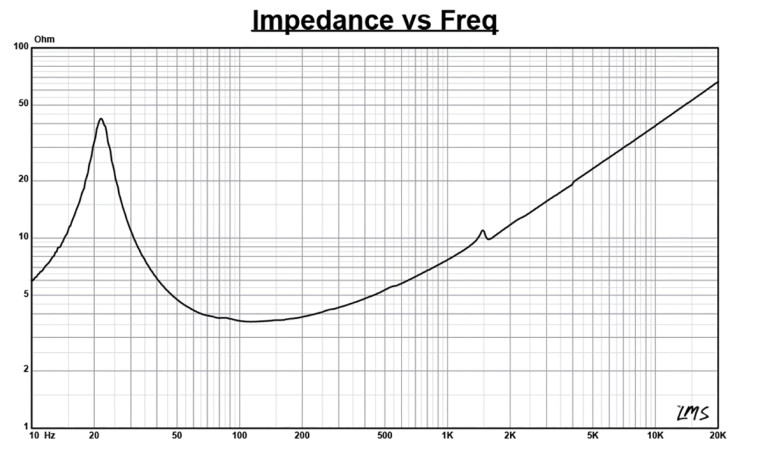

From the comparative data shown in Table 1, you can see that all four parameter sets for the two samples were very consistent and correlated fairly well with the factory data, except for the Vas and Sensitivity numbers. I think this can be accounted for by the difference in Sd (337cm2 based on a 20.7 center of surround to center of surround diameter vs 312cm2 factory). Knowing this, I programmed the factory data in LEAP 5, and the results produced a similar F3 and Qtc, but SPL that was 3dB different. I followed my normal protocol for Test Bench testing, and used the Sample 1 LEAP 5 LTD parameters and set up two computer box simulations. The first was the factory recommended 1.4ft3 sealed enclosure with 50% fill material (fiberglass). The datasheet stipulates that users not attempt vented enclosure incarnations with this driver, so since the Qtc of the 1.4ft3 box was fairly low (Qtc=0.62). I set up a second simulation that was half that size, a 0.7ft3 sealed box, also with 50% fill material.
Figure 2 gives the results for the SW26DBAC76-4 in the two sealed enclosures at 2.83V and at a voltage level sufficiently high enough to increase cone excursion to Xmax+15% (13.8mm for the SW26DBAC76-4). This resulted in a F3 of 35Hz (-6dB=27Hz) with a Qtc=0.60 for the 1.4ft3 closed box and a -3dB for the 0.7ft3 closed box simulation of 40Hz (-6dB=32Hz) and Qtc=0.73. Increasing the voltage input to the simulations until the approximate Xmax+15% maximum linear cone excursion point was reached resulted in 109dB at 45V for the larger sealed enclosure simulation and 112dB with a 52V input level for the smaller closed box simulations. Figure 3 shows the 2.83V group delay curves. Figure 4 shows the 45V/52V excursion curves.

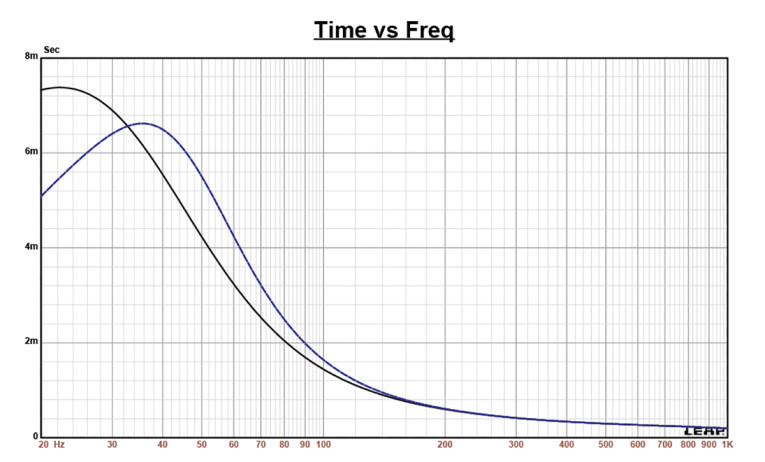
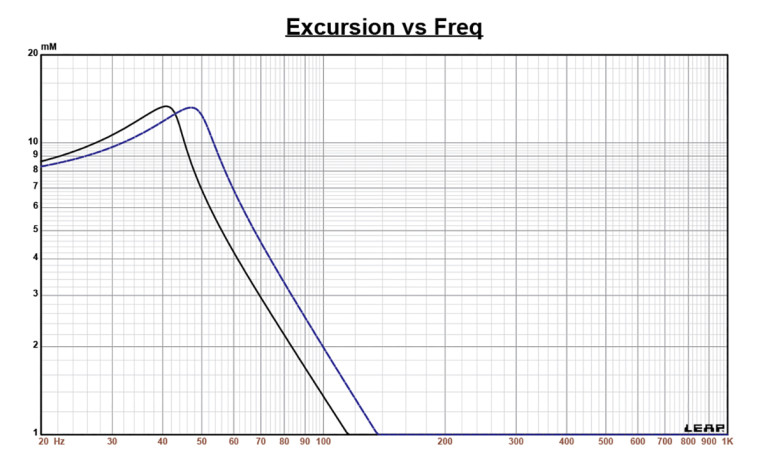
Klippel analysis for the SB Acoustics SW26DBAC76-4 subwoofer was performed at the Warkwyn facility by Jason Cochrane and produced the Klippel data graphs given in Figures 5-8.
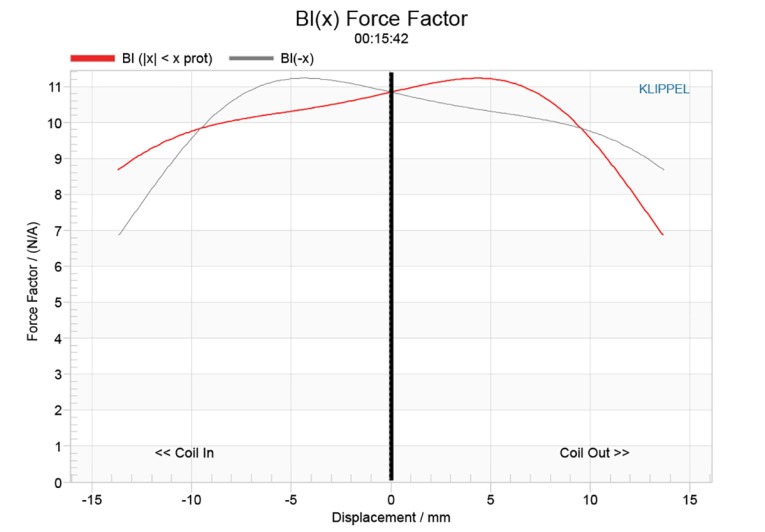


The Bl(X) curve for SW26DBAC76-4 (Figure 5) is fairly broad with a substantial degree of tilt and asymmetry. Looking at the Bl Symmetry curve (Figure 6), you can see a coil-out offset at 3mm of excursion of about 3.9mm, but this decreases to 0mm at 9.5 mm of excursion, finally morphing to 1mm coil-in at the 12mm physical Xmax of the driver. There was similar asymmetrical behavior exhibited by the Wavecor SW280WA01 shallow subwoofer examined in the June 2019 issue of Voice Coil magazine. Empirically, both woofers work well subjectively in small sealed enclosures, so while the Bl behavior is non-ideal, it’s also not a deal breaker in terms of practical and useful performance.
Figure 7 and Figure 8 show the Kms(X) and Kms symmetry curves for the SW26DBAC76-4 subwoofer. The Kms stiffness of compliance curve (Figure 7) is very symmetrical, with only minimal coil-in offset. The Kms symmetry range curve has a minor 1.4mm coil-ln (rearward) offset at 3mm of excursion, decreasing to a trivial 0.2mm at the 12mm physical Xmax of the driver.
Displacement limiting numbers calculated by the Klippel analyzer for the SW26DBAC76-4 using the 70/50 subwoofer criteria for Bl was XBl @ 70% (Bl dropping to 70% of its maximum value) equal to 12.77mm (somewhat beyond the physical 12.0mm Xmax for this driver) for the prescribed 20% distortion level. For the compliance, XC @ 50% Cms minimum was 8.0mm, which means that for the SB Acoustics SW26DBAC76-4 the compliance is the more limiting factor for getting to the 20% distortion level.
Figure 9 gives the inductance curve Le(X) for this transducer. Motor inductance will typically increase in the rear direction from the zero rest position and decrease in the forward direction as the voice coil moves out of the gap and has less pole coverage, but that doesn’t happen with this motor due to the effectiveness of the aluminum shorting ring. What we get is an inductance swing from Xmax in to Xmax out of 0.67mH to 0.58mH (0.09mH delta), which is decent inductive performance.

Given that the SW26DBAC76-4 is a subwoofer mostly intended for applications below 100Hz, I dispensed with the SPL measurements since this driver will not likely be crossed over much over 100Hz. That said, the factory-generated frequency response curve can be seen in Figure 10. I also dispensed with time-frequency analysis for subwoofers as the data is not really significant below 100Hz.
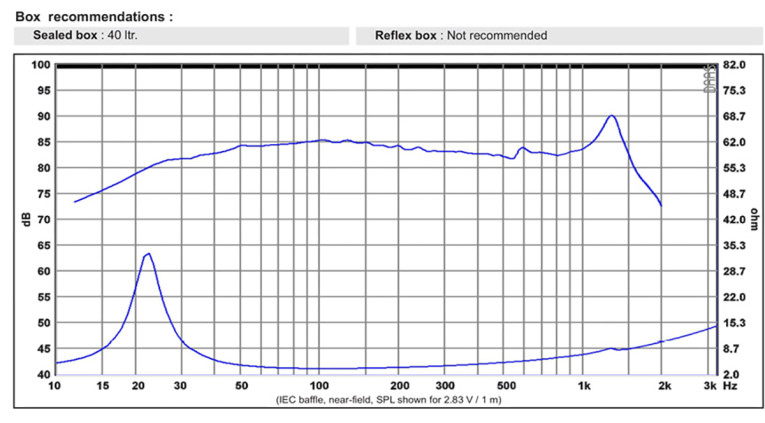
I then commenced the last phase of testing using the Listen, Inc. SoundCheck analyzer to perform distortion analysis. For distortion measurements, the voltage level was set with the driver securely mounted on a stand in free-air and the voltage drive was increased until it produced an 1m SPL of 94dB (my SPL standard for home audio drivers), which occurred at 8.2V.
The distortion measurement was then made with the microphone placed near-field (10cm) with the woofer mounted in free air. This plot is shown in Figure 11 for the SW26DBAC76-4 subwoofer. As can be seen, this actually includes two plots, the top graph being the standard fundamental SPL curve with the second and third harmonic curves, and the bottom graph the second and third harmonic curves plus the THD curve with an appropriate X-axis scale. Interpreting the subjective value of conventional distortion curves is almost impossible; however, looking at the relationship of the second to third harmonic distortion curves is of value. As can be seen, third-order harmonic distortion is less than 3% from 30Hz to 50Hz, and less than 0.5% from 50Hz to 100Hz.

Looking over all the data obtained on the SB Acoustics SW26DBAC76-4 shallow mount 10” subwoofer, this is a well-crafted driver with good sealed box performance, especially considering the feat of getting that performance out of driver that is barely 3” deep. For more information, visit the SB Acoustics website at www.sbacoustics.com. VC
This article was originally published in Voice Coil, January 2023.




